Draft Sectoral Marine Plans for Offshore Renewable Energy in Scottish Waters - Environmental Report Appendix B: Baseline Information
Appendix B to the SEA Environmental Report of the Draft Sectoral Marine Plans for Offshore Renewable Energy in Scottish Waters.
This appendix contains Baseline Information.
1.7 Historic Environment
Key Issues Summary
- While a number of coastal and marine historic environment assets are protected by designation, there are gaps in knowledge regarding the location and status of many marine sites.
- Potential for adverse impacts to marine and coastal archaeology from the physical siting and operation of marine developments and associated infrastructure activities.
- The setting of coastal features of interest can be impacted by changes resulting from marine and coastal development.
- The sensitivity of many coastal historic assets and the potential for impacts to coastal archaeology from changes in coastal processes and increased erosion exacerbated by offshore development.
National Marine Baseline
1.7.1 Scotland's historic environment and cultural heritage help to create a sense of place, wellbeing and identity, enhancing the distinctiveness of the coast and attracting visitors to Scotland [192] . A wide range of archaeological sites can be found on the foreshore and seabed ranging from the remains of ships and aircraft lost at sea, to valued harbours, lighthouses and other structures at the coastal fringe.
1.7.2 These historic assets are a non-renewable resource, and their survival is conditioned by a complex interplay of natural and man-made factors. The combination of seawater and sediment provides an important setting within which the preservation of archaeological remains is supported. Natural factors such as seabed movement from wave and tidal energy, relative sea-level rise, seabed topography and sediment type, biological colonisation, salinity, water acidity or alkalinity and levels of oxygenation often present conditions suitable for their preservation [193] .
Historic Assets in Coastal and Marine Environments
1.7.3 While many sites lie wholly within the marine environment, it is believed that there are many more unprotected sites of interest on and around Scotland's coastline [194] . The Orkney and Shetland coasts in particular, contain many Neolithic and Mesolithic structures that are now below sea level. As such, Scotland's seabed and inter-tidal areas contain the remains of many important historic assets, ranging from artefacts and structures deposited on the seabed, structures built on the seabed or in inter-tidal areas, and submerged sites that were previously above sea level.
1.7.4 At present more is known about historic assets on land to those in marine and coastal environments. Historically, there has been a heavy reliance on ad hoc discoveries of sites in coastal areas rather than through data gathered in structured research frameworks and survey programmes [195] . However, since 1995, the Royal Commission on the Ancient and Historical Monuments of Scotland ( RCAHMS) has recorded maritime information from readily available sources, a process that is now undertaken regularly for terrestrial sites. However, despite significant progress being made, the shortage of accurate locations and descriptions for most reported sites remains an issue.
Designations
1.7.5 Scotland has 34 statutory designated sites wholly within the marine environment. These include eight designated wreck sites, nine scheduled monuments including seven wrecks in Scapa Flow, four listed buildings and 13 sites designated under the Protection of Military Remains Act 1986 [196] . It is thought that many more such sites exist, and more coastal sites are likely to be known locally, but remain unreported as archaeological sites [197] .
1.7.6 It is estimated that there are 38,000 historic and unprotected sites of interest around Scotland's coast. These areas include St Kilda and the Heart of Neolithic Orkney World Heritage Sites ( WHS), scheduled monuments, gardens and designed landscapes, archaeological remains, listed buildings and other sites located in conservation areas around our coastline [198] . There are 97 managed and accessible coastal and marine heritage sites ranging from the two World Heritage Sites, coastal properties in care of Historic Scotland, maritime and coastal heritage museums, historic ships and designated wreck sites [199] . For these sites, the sea can be an integral part of their setting and a key element in how they are experienced, understood and appreciated. The Inventory of Gardens and Designed Landscapes also recognises 390 nationally important sites, some of which have coastal locations [200] .
1.7.7 WHS status is governed by the United Nations Educational, Scientific and Cultural Organisation ( UNESCO). Where development has the potential to affect a WHS the consenting authority should protect and preserve its Outstanding Universal Value ( OUV). UNESCO states that OUV reflects cultural and/ or natural significance which "is so exceptional as to transcend national boundaries and of importance for present and future generations of all humanity" [201] . The statement of OUV is key for the future effective protection and management of the WHS and has been considered within management plans for St Kilda and the Heart of Neolithic Orkney WHS [202] [203] .
1.7.8 The Marine (Scotland) Act 2010 provides for the designation of Historic Marine Protection Areas (Historic MPAs) [204] . Consultation opened on 18 March 2013 on amendments to the Drumbeg Historic MPA and proposals for a further six Historic MPA:
- Campania, Firth of Forth;
- Dartmouth, Sound of Mull;
- Duart Point, Sound of Mull;
- Kinlochbervie, Sutherland;
- Mingary, Ardnamurchan; and
- Out Skerries, Shetland.
1.7.9 The designation process covers the transition of existing designated wreck sites and underwater scheduled monuments to MPA status and identification of further priority sites.
Pressures on coastal and marine archaeology
1.7.10 Key relevant pressures to Scotland's coastal and marine heritage assets include coastal and offshore development, the effects of climate change, and coastal erosion and flooding [205] . Coastal erosion poses a major issue for historic and archaeological sites in many coastal areas, and one that is likely to be exacerbated given predictions of the likely effects of climate change ( e.g. sea level rise, increased intensity of storms, erosion and risk of flooding) [206] . Among the sites most at risk are some of Scotland's unique and special sites, such as Skara Brae in Orkney [207] .
1.7.11 Coastal and marine development is a known driver of change in the marine historic environment [208] . Vessel anchoring, dredging, and construction of port facilities, bridges, and offshore developments have the potential to adversely affect these resources [209] . However, the survival of individual marine heritage assets can be highly variable and evidence shows that high levels of preservation can occur where seabed conditions allow and disturbance is avoided [210] .
Figure B1.7.1: Map of Scotland's Marine Coastal Heritage Designations [211]
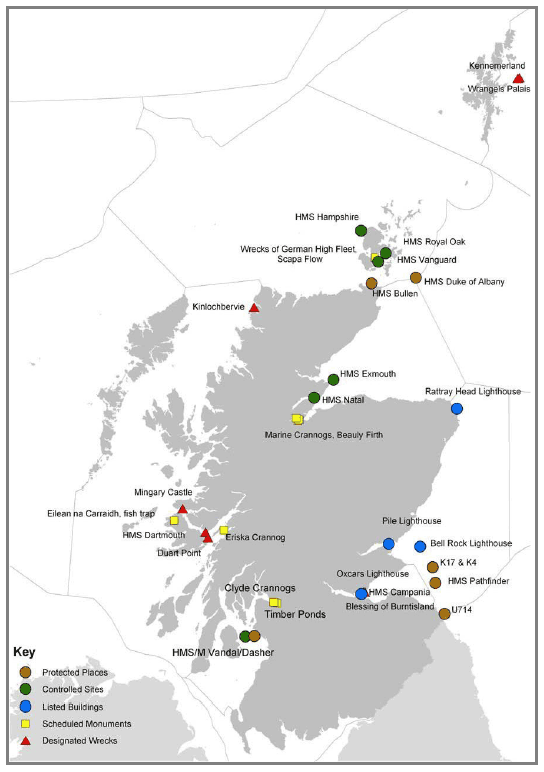
Regional Baseline
North East
1.7.12 While there are no designated historic sites in the north east region or the plan option areas, this marine area has a high concentration of wreck sites, particularly at or near to the coastline at the north east tip between Fraserburgh and Peterhead.
1.7.13 The Aberdeenshire coastline contains a range of sensitive coastal sites and buildings with historic interests. Of particular note are the A-listed Girdleness Lighthouse in Aberdeen, and Castle Cowie and Dunnottar Castle near Stonehaven on the eastern coast; and numerous sensitive coastal sites such as scheduled Kinnaird Head Castle and Lighthouse, and other castles and churches located around Fraserburgh.
Figure B1.7.2: Historic Environment Designations in the North East
Heritage designations. North East area
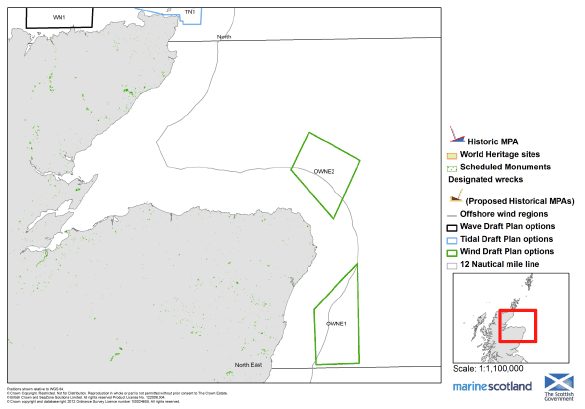
North
Shetland
1.7.14 The Shetland region contains a wide variety of coastal and marine historic features, the most notable being the protected wreck sites at Kennemerland and Wrangels Palais at Out Skerries [212] , proposed as an Historic MPA by Historic Scotland. A large number of other wrecks have been located around the Isles, including some 14 locally protected wreck sites located mainly along the east Shetland coastline [213] . Extensive areas along the Shetland coastline and waters have also been identified as being potentially of interest for submerged archaeology.
1.7.15 The Shetland coastline contains a range of sensitive and/or listed sites including buildings, brochs, forts, monuments and other sites with historic interests, largely in clusters across the many islands, and many identified as being at risk as a result of coastal erosion. Of particular note is the A-listed Sumburgh Head Lighthouse at the southern tip of the Shetland mainland, Muckle Flugga lighthouse in the north, and Inner Skaw houses and field system in North Unst.
Orkney
1.7.16 The Orkney isles and surrounding waters contain a wide variety of coastal and marine historic features, the most notable being the Heart of Neolithic Orkney World Heritage Site covering most of the western coastline of West Mainland and Hoy, and the remains of seven scheduled wrecks of ships from the German High Seas Fleet in Scapa Flow. A voluntary underwater conservation zone is in place around these wrecks. A large number of other wrecks have been identified around the Orkney Islands, with several in proximity to the plan option areas located to the north, west and south of the islands. Extensive coastal and marine areas around the islands have been identified as potentially being of interest for submerged archaeology.
1.7.17 The Orkney Isles contain a wide range of listed buildings and scheduled monuments including lighthouses, brochs, fortifications, cairns, chapels, dwellings and other monuments with varying levels of listing and importance located around the Orkney coast. Of particular note are the A-listed Pentland Skerries Lighthouses, Stackel Brae castle near the Pentland Firth; and monuments on the Island of Stroma.
North Mainland
1.7.18 The North Sutherland and Pentland Firth coasts and their adjacent waters contain a number of coastal and marine historic features, largely comprising offshore and coastal wrecks, and a range of listed buildings and historic monuments. These monuments include the prehistoric coastal remains of brochs, standing stones, stone rows, tumuli and chambered cairns [214] . In general, the eastern part of the North Sutherland coast contains a larger number of these coastal sites than the western portion, with the highest densities generally located in the more populated areas ( e.g. Thurso) [215] .
1.7.19 The Pentland Firth is also recognised to have high potential for submerged cultural features such as prehistoric landscapes, shipwrecks and anchorages [216] . The Firth also contains the wreck of HMS Bullen, designated under the protection of Military Remains Act 1986, and the wreck of HMS Duke of Albany located to the east of the Firth [217] . Other notable historic sites in this region include the A-listed Castle of Mey and its designated gardens located near John O'Groats and around 500m from the coast.
Figure B1.7.3: Historic Environment Designations in the North
Heritage designations. North area
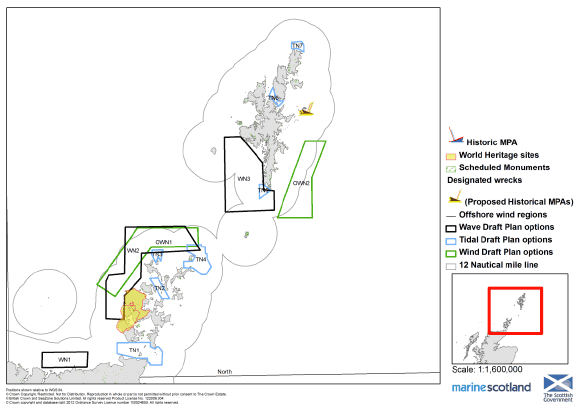
North West
North West Mainland
1.7.20 Scotland's north west coastline and its adjacent waters, contain a range of coastal and marine features of historic significance. The western coastline to the south of Cape Wrath contains one Historic MPA at Kinlochbervie and a proposed Historic MPA located near Ardmore Point, both based around historic wreck sites. The North Minch contains a large number of known wrecks located in both coastal and marine areas, with numerous sites located within the offshore wind energy area of search ( OWNW1).
1.7.21 A number of listed buildings and scheduled monuments are located in this area, ranging from historic buildings to scheduled monuments with varying levels of listing and importance. Of particular prominence is the A-listed Cape Wrath Lighthouse located at the north west point of the Scottish mainland.
Western Isles and St Kilda
1.7.22 The western isles and its adjacent waters contain a number of coastal and marine historic features. While no designated wrecks are located in this region, a number of known wreck sites have been identified around the east and north west coastlines, and further offshore in the Minches. Several isolated wreck sites have also been identified located to the west of the Isles within the offshore wave energy area of search ( WNW1). Clusters of known wreck sites have been identified in coastal areas near Stornaway, Scalpay, Barra and the Sound of Harris. In addition, the east and north west coasts of Lewis, and the coastal regions of North Uist, Benbecula and South Uist have been identified as potentially being of interest for submerged archaeology.
1.7.23 The Western Isles also contain a vast array of land-based historical features, many of which have coastal relevance. These sites largely consist of scheduled and unscheduled monuments including duns, cairns and forts, with a range of listed buildings also identified along the coastline. A particularly high density of these sites has been identified in the northern portion and along the north west coast of the Isle of Lewis, with other clusters of sites identified in the southern isles ( e.g. Barra, Mingulay and Sandray). Notable sites include the A-listed lighthouses at Barra Head and the Butt of Lewis, a concentration of sites in Port Nis on Lewis, and the St Kilda archipelago, located 66km west of Benbecula, designated as a WHS.
Figure B1.7.4: Historic Environment Designations in the North West
Heritage designations. North West area
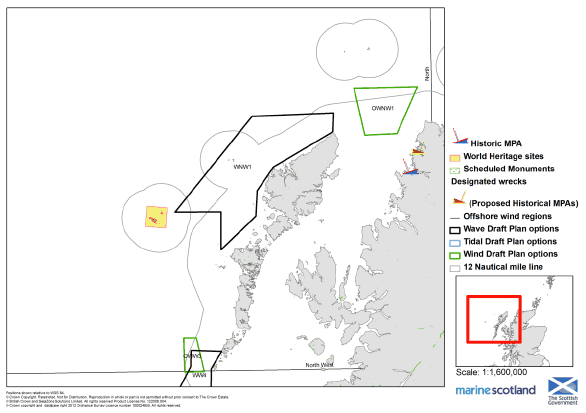
West
1.7.24 The long and complex coastlines within Scotland's western isles contain many sites of historic features, and significant sections of coastal and marine areas in Tiree, Colonsay, Islay and Kintyre have been identified as being of potential interest for submerged archaeology. There are a number of marine and coastal wreck sites along the many coastlines within this region, including small clusters of wreck sites located near the west coast of Tiree, the west and south coasts of Islay, and along the southern and south east coasts of Kintyre. All of these sites are located adjacent to offshore wind, wave and/or tidal plan option areas.
1.7.25 These valued coastal areas also contain a wide range of historical features. These include designated sites such as lighthouses and listed buildings, scheduled fortifications, early church sites and a range of other monuments of varying importance and designation. Notable sites in the region include Iona Abbey on Iona, Dhu Heartach Lighthouse in Colonsay, Rinns of Islay Lighthouse in Orsay, coastal chapels in the Oa, and A-listed Skerryvore Lighthouse in Tiree.
Figure B1.7.5: Historic Environment Designations in the West
Heritage designations. West area
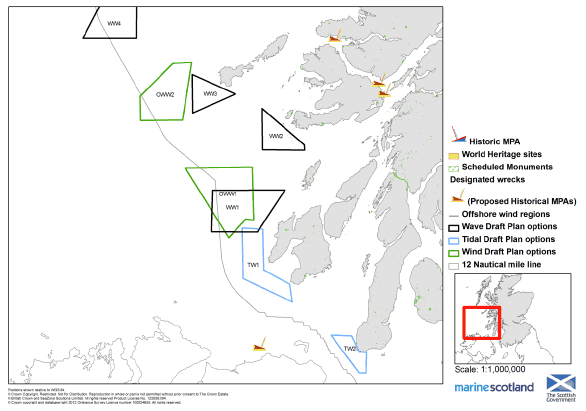
South West
1.7.26 While no designated wrecks are located within this region, there are a plethora of marine and coastal wreck sites to the west of the Rhins Peninsula, within Luce Bay and located further east within the Solway Firth. Much of the coastline along the western edge of the Rhins Peninsula and within the Solway Firth itself has been identified as potentially being of interest for submerged archaeology.
1.7.27 The Firth's coastline contains a wide range of historical features, including those at or close to the shoreline, and also sites considered to have a coastal relevance. The south coast of Dumfries and Galloway in particular is a rich area in terms of scheduled coastal sites, with particularly with large numbers of scheduled monuments, unscheduled monuments and listed buildings are located near the Mull of Galloway, Burrow Head and Abbey Head. These areas are located in proximity to the offshore wind or tidal plan option areas.
Figure B1.7.6: Historic Environment Designations in the South West
Heritage designations. South West area
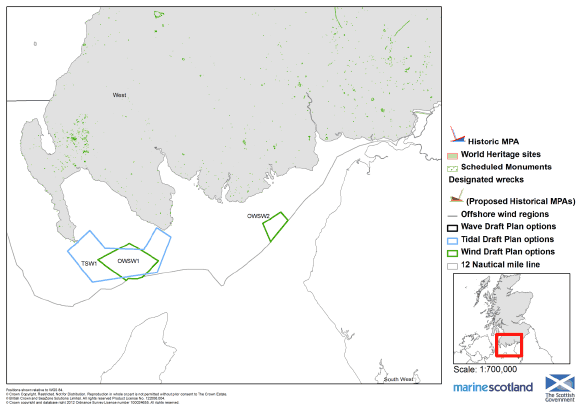
Contact
There is a problem
Thanks for your feedback